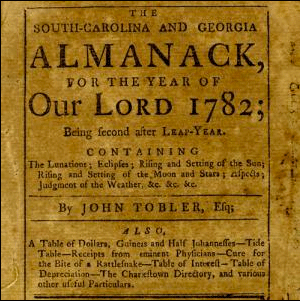About

Very likely the earliest known printing of a directory of any American city or town, the first directory of Charleston was published as the American Revolutionary War was drawing to a close. It appeared in the South Carolina and Georgia Almanack for the Year of Our Lord 1782 by John Tobler under the caption The CHARLESTON DIRECTORY and an original is included in the Charleston Library Society’s collection of the city’s directories.
City directories generally contain listings of the areas’ residents — including names, addresses, and occupations – as well as separate registers of businesses and professions usually sorted according to the nature of the work. Some contain “reverse look up” listings whereby an individual or business can first be identified by street address. Many also contain sections pertaining to government, weights, measures, tariffs, maps, street references, city histories, and business advertisements. Directories are an important primary resource of historic material for amateur and professional researchers. Genealogical investigations are, perhaps, the most obvious examples: locating ancestors; searching censuses by address; exploring years between censuses; identifying dates of death; noting life alterations such as career changes and the names of people who lived with ancestors; verifying other documents; and discovering clues to locations of other documents and sources of information, to name a few. Elaboration of historic narrative – as, for example, the schedule and tariff of a local train to be involved in a movie story — can often be more realistically accomplished through use of directory material. Similarly, images of earlier contemporary life can often be pieced together from the business, church, governmental, societal and advertising materials of directories. Studies of maps and street changes are very likely to reveal physical alterations in the city over time.
More specifically, the Charleston Library Society’s collection of Charleston city directories, which contains most if not all those printed from the first in 1782 to the present, have been and can be used for all of those purposes and more. The introduction to the 1875 – 76 directory noted that it was being published to keep pace with the increase in business and changes in the city that were apparent to the merchants and citizens and severely felt as a result of the influx of strangers. The 1856 version was probably titled the City Directory and Stranger Guide with the same thoughts in mind. At least as early as 1891 the Charleston directory included a reverse look up by street list, and at least as late as 1958 some of the directories contained separate listings for “white residents” and “colored residents.”
In the CLS’s The Charlestown Directory for 1782 and The Charleston Directory of 1785 there is a forward by Mary A. Sparkman, Commission Secretary. The forward provides a number of examples in which the author used information from those two Charleston directories, often in conjunction with and through cross referencing other source materials, to identify local figures of historical note and their resident addresses, including the infamous Lieutenant Colonel Balfour (the Commandant of Charlestown who hanged the martyr Hayne), Lieutenant- Governor Bull (native-born and bred but still a Royalist), Dr. Charles Fyff (“Physician to the Refugees”), Dr. Alexander Garden (for whom the Gardenia was named), and Dr. Elisha Poinsett (the father of Joel R. Poinsett who a half century later brought the Poinsettia from Mexico to this country where it was named). It also gives examples of: reconstructing the city’s development as its original fortifications were demolished; following the alterations in street names and locations over time; and, determining the changing business and residential nature of the city’s neighborhoods.
Some of the directories in the CLS collection contain much more extensive information about individuals than is typical. For example, the 1975 directory may show for any particular individual: full name, address, wife’s name, telephone number, occupation and employer, if a student aged 18 and older, if an out of town resident employed in the area, the branch if an armed forces member, the home owner, the suburb designation, if a head of household, if widowed, if unmarried and unemployed, and if the owner of a private business the name of the business. For resident corporations it lists the corporate officers and the nature of the business, and for resident partnerships it identifies the partners. The possible uses of all of this information are probably limited only by the researchers’ imaginations.
